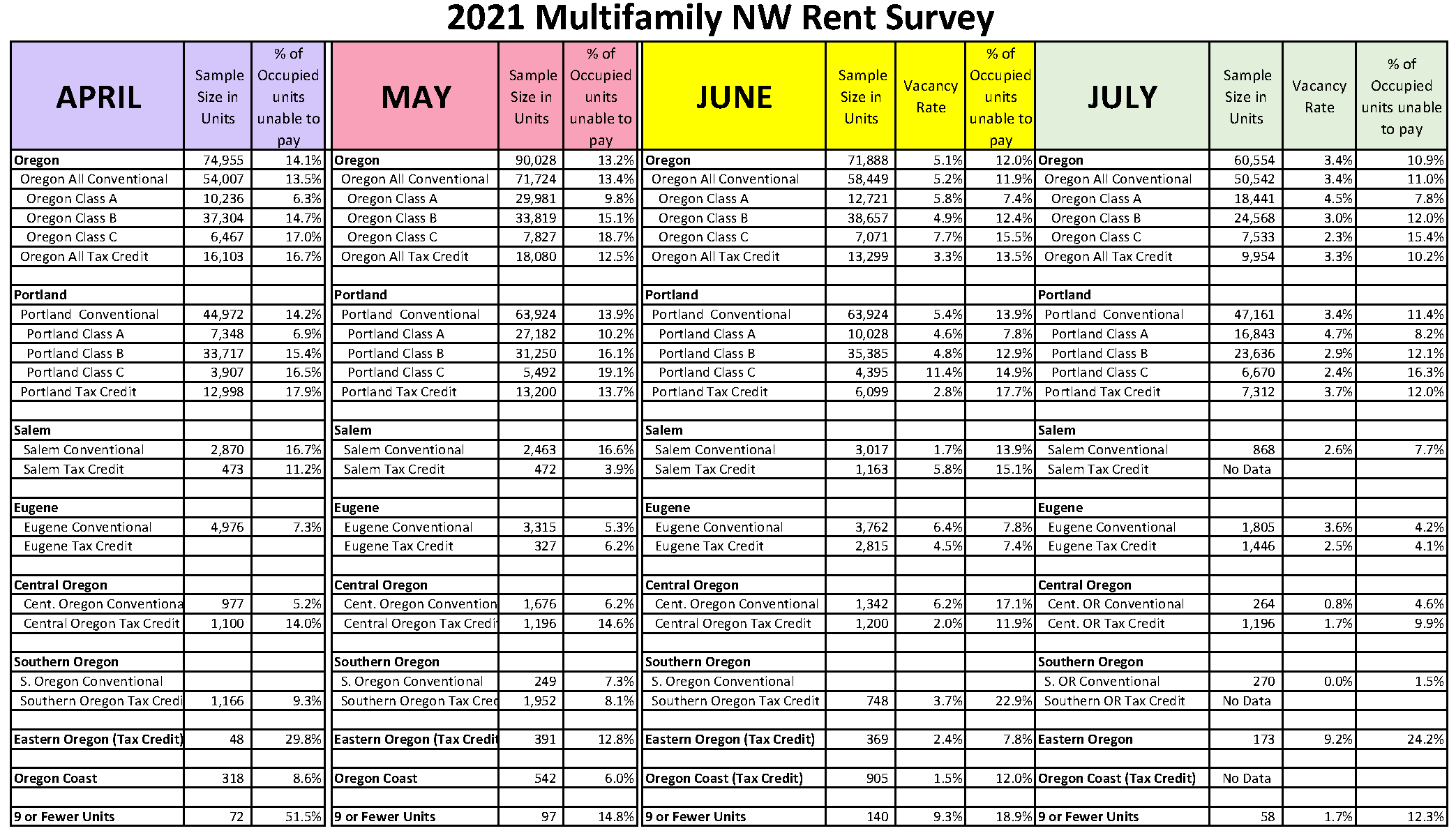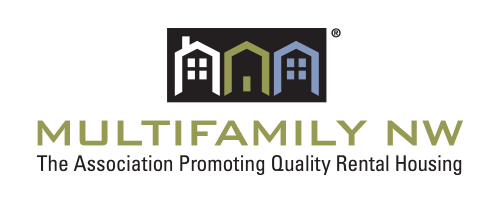July 2021 Rent Survey Results
 Click the image above to zoom into the data table.
Click the image above to zoom into the data table.
Dear Members,
Multifamily NW collaborated with a broad group of housing professionals (management companies, private managers, housing authorities, nonprofits, and state agencies) to collect surveys of conventional and affordable rental housing to track trends in ability to pay rent in occupied units across Oregon. Over the past 15 months we have received over 3,500 unique surveys representing well over a million units.
Key findings for July:
- On average, 10.9% of Oregon households did not pay their rent by the 15th of the month, which represents a consistent trend in improvement since April: 14.1% in April, 13.2% in May, 12% in June and now under 11% in July. Note that the survey collects data as of the 15th, and patterns of rent payment have been altered by Oregon legislation, with tenant rent payments continuing throughout the month and arrival of rent assistance being unpredictable.
Statewide, conventional housing showed moderate improvement between June and July, improving from 11.9% to 11.0% nonpayment. - In the statewide sample of Affordable Tax Credit units, 10.2% were unable to pay rent, a 3% improvement when compared to the average of 13.5% the previous month.
- Conventional Class-C workforce multifamily housing continued to experience the most serious housing insecurity with a 15.4% inability to pay rent, virtually unchanged from June. Renters in this housing type have consistently been the most impacted by inability to pay throughout the pandemic. Market rate Class C housing also reported the lowest vacancy rate of all asset types, at 2.3%.
- Nine or Fewer Units - We received only 19 surveys from owners with nine or fewer units, representing only 58 units. This sample showed 12.3% inability to pay, compared to over 18% last month. There is high variability in this cohort each month, with a different group of owners electing to respond. However, each month we receive consistent messages that owners of this asset class have made the decision to sell their rental units.
Additional Comments:
- “One of the main issues we are coming across is often a tenant may have applied for rental assistance after we applied for (funding through) another program. What tends to happen in this case is that due to the inflexibility of the funds, we need to return one of the funding streams which causes delays and confusion for the tenant.”
- “More people paid this month, but a lot of units just showed proof of applying for housing help.” (Note: providing evidence of applying for rental assistance provides the resident with a 60-day period of eviction protection. This is currently 90-days in Multnomah County.)
- “The 5 (apartments) that are vacant need repairs & I don't have the money to do so. It takes an act of congress to get a loan. I have excellent credit. Too many fees.”
- “…Landlords have been unfairly treated during this entire Covid period.
- “I feel that the tenant should be required to prove to the landlord his or her change in income.”
Note on Methodology:
The survey asks: “How many occupied households were unable to pay full rent by the 15th day of the month?” The survey then adjusts for vacancy to arrive at the true percentage of occupied households that are unable to pay their full rent.
Definitions
Real estate professionals often use categories (A, B, or C) to describe rental properties after considering a combination of factors such as age of the property, location of the property, growth prospects, appreciation, amenities, and rental income. There is no uniform or precise formula for establishing these categories.
Class A - These properties represent the highest quality buildings in their market and area. They are generally newer properties built within the last 15 years with top amenities and demand the highest rent with little or no deferred maintenance issues.
Class B - These properties are close to Class A designation being generally older and typically offer fewer amenities. Rent is typically lower than Class A.
Class C - Class C properties are typically more than 20 years old and are not as well located. Due to a variety of factors, Class C buildings tend to have the lowest rent rates in the Conventional Housing market when compared to Class A and B properties.
Conventional Housing – Market-rate housing with no household income limits, rent limits, or special programmatic requirements in the financing.
Affordable Housing – Government financed housing (Often using Tax Credits or Bonds) that impose initial household income limits and maximum rent limits, all predicated on affordability calculations based on the area median income.
Thank you to every member and participant that took the time to complete the monthly Rent Surveys that created these important data sets.
